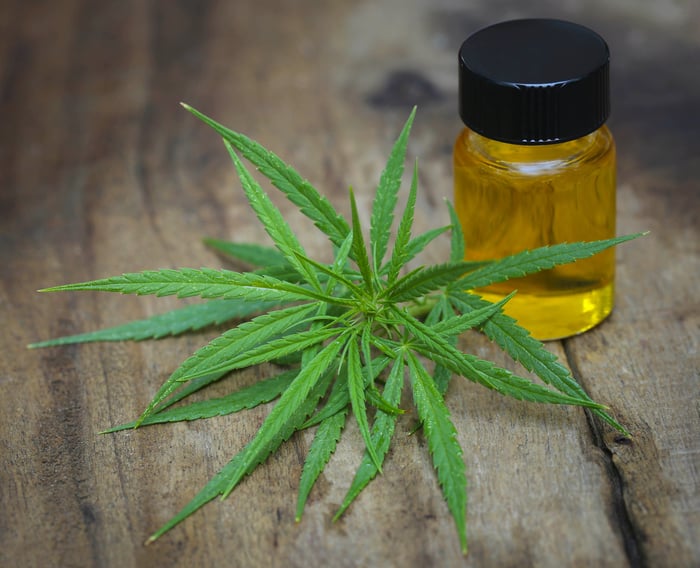The marijuana industry is maturing at an exceptionally quick pace. The legalization of recreational cannabis, a previously taboo product, in Canada last year tossed that idea out the window for good. Now the pot industry has a vibrant future, as evidenced by Cowen Group's forecast that global sales could hit $75 billion by 2030.
But as investors, we're also acutely aware that not every company can be a winner. Sure, there's a lot of money to be made with the legalization of cannabis in various parts of the world, but not every company is going to have the tools or the timing to take advantage of this growth.

Image source: Getty Images.
Emerald Health has lagged its peers for some time
One such company that's received little respect from Wall Street is British Columbia-based grower Emerald Health Therapeutics (EMHT.F). At a market cap of $372 million as of the end of trading on Monday, Feb. 11, it's the lowest-valued grower that's expected to hit at least 100,000 kilograms in peak annual production.
Emerald Health's big break came in 2017 when it formed a 50-50 joint venture with Village Farms International (VFF -6.92%), known as Pure Sunfarms. Village Farms already had vegetable-growing greenhouses in place, allowing Emerald Health to partner up in order to retrofit these existing facilities to produce cannabis. Not having to build greenhouses from the ground up is a time- and cost-saving measure. The 1.1-million-square-foot facility being retrofit should be producing at least 75,000 kilograms annually when complete and fully licensed.
The problem is that Emerald Health has been lagging its peers. While marijuana sales weren't exactly robust prior to the legalization of recreational weed on Oct. 17, Emerald Health's revenue was almost nonexistent. Through the first nine months of fiscal 2018, Emerald Health didn't even hit 1 million Canadian dollars in revenue, and it only had CA$2.84 million in inventory. By comparison, Aurora Cannabis just reported CA$54.2 million in sales and nearly CA$80 million in inventory in its fiscal second quarter, ended Dec. 31, 2018.
To put it mildly, Emerald Health has had a lot of built-in risk, ranging from obtaining licensing to diversifying its product portfolio away from dried cannabis flower, which runs the risk of being commoditized over time. However, it looks as if many of these risks are beginning to abate, with Emerald Health really turning things around in recent weeks.

Image source: Getty Images.
The stars are beginning to align for Emerald Health Therapeutics
In terms of licensing, the most recent update investors received is that 825,000 square feet out of close to 1.03 million square feet that'll be devoted to growing have been licensed by Health Canada. It's now just a matter of probably two months or less before Emerald Health and Village Farms are fully licensed for cultivation at Pure Sunfarms.
Moving forward with Pure Sunfarms' licensing is important, because the joint venture announced on Feb. 8 that it had entered into a supply agreement with the Ontario Cannabis Store (OCS). OCS represents Emerald Health's and Village Farms' first provincial distribution agreement, albeit Pure Sunfarms must wait on packaging and processing licenses from Health Canada before it can begin shipping product to Ontario. The company expects these licenses to be issued in the near term.
We're also seeing much-improved breadth of production. Last week, Emerald Health entered into a licensing agreement with privately held Italian company Indena to utilize its cannabidiol (CBD) extraction technology and contract manufacturing services for CBD extraction. CBD is the nonpsychoactive cannabinoid best known for its perceived medical benefits, and the Brightfield Group is forecasting global sales growth in CBD products to $22 billion by 2022. In other words, the company is attempting to focus on higher-margin alternative cannabis products.
Speaking of alternative products, Emerald Health also has approximately 1,000 acres of hemp to harvest each year between 2019 and 2022. Hemp is rich with CBD and contains very little tetrahydrocannabinol (THC), the cannabinoid that gets a user high. Utilizing Indena's extraction technology should expedite Emerald Health's ability to process this hemp and utilize it for its high-margin CBD oil.

Image source: Getty Images.
Time to buy?
The puzzle pieces are finally beginning to come together for Emerald Health. The big question is, does that merit a higher valuation? As you might expect, this isn't an easy question to answer.
Presumably, if Emerald Health can take advantage of its hemp crops and partnership with Indena to substantially increase the percentage of total sales deriving from CBD oils, it should be able to generate a gross margin that's on par with or above that of most of its peers. Ultimately, it's profits that matter most, even if that's sort of been lost on investors in the early going of the recreational rollout. In this respect, yes, it would appear that Emerald Health isn't getting enough credit, if it can hit its objectives.
Arguably my biggest concern with the company is its yield. Keeping in mind that there's only so much Emerald Health can do with retrofitting an existing greenhouse, it just seems disappointing that 1.03 million square feet of growing space will yield around 75,000 kilograms at peak production. The average production yield throughout the industry tends to be closer to 100 grams per square foot, meaning Emerald Health is about 25% below par in this respect. So in this instance, no, Emerald Health doesn't deserve a higher valuation.
Ultimately, I still believe Emerald Health is best observed from the safety of the sidelines, although I no longer believe it carries an extraordinary amount of risk relative to reward among marijuana growers.
Check out the latest earnings call transcripts for companies we cover.





